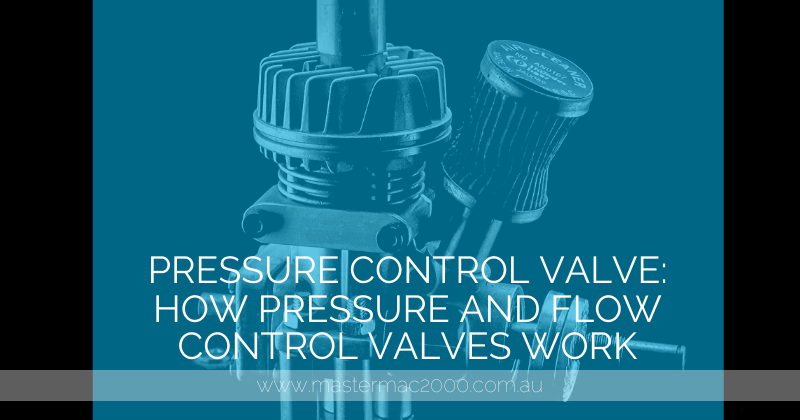Pressure Control Valve: How Pressure and Flow Control Valves Work
 For a pneumatic system to function, both pressure and flow are needed. However, the relationship between the two is often misunderstood by some. The pressure is measured in pound-force per square inch (psi), and it assesses the performance of an air compressor at any given time. On the other hand, flow is usually measured in cubic feet per minute (cfm), and is defined as the ability of an air compressor to operate consistently.
For a pneumatic system to function, both pressure and flow are needed. However, the relationship between the two is often misunderstood by some. The pressure is measured in pound-force per square inch (psi), and it assesses the performance of an air compressor at any given time. On the other hand, flow is usually measured in cubic feet per minute (cfm), and is defined as the ability of an air compressor to operate consistently.
For a pneumatic system to function effectively, it needs the assistance of valves. Valves are mechanical devices that are responsible for different pneumatic operations — such as stopping, reducing, controlling, or regulating the pneumatic flow or pressure.
Valves are designed to work in specific purposes and are used in various ways. That is why they are categorised accordingly by the flow-paths they create and their number of ports. Pressure regulators, venting regulators, and needle valves are the essential devices that are present in a pneumatic system.
How Pressure Regulators Work
In a compressed air system, regulator valves are used to maintain continuous output pressure. Pressure regulators comprise actuating, control, sensing, and integral loading components, which make them a special class of valve. As the pressure moves through a pneumatic system, a pressure regulator operates with sensors to monitor its expansion.
How Venting Regulators Function
Although venting-type regulators function similarly to a pressure regulator, they also serve as a small exhaust valve that enables the release of pressure.
There are two methods to release excess pressure:
- Internal bleeding system – the additional pressure is redirected by the venting regulator.
- External bleeding system – a venting regulator permits the release of excess pressure out of the system.
Rather than allowing the increase of pressure, venting-type regulators serve as pressure monitors to make sure it stays at a lower level while it enters the pneumatic system and traverses through the venting-type regulator.
How Needle Valves are Used
These valves are utilised to control the flow by limiting the amount of air needed inside the pneumatic system. Needle valves feature an adjustable component to limit or decelerate the flow — this is to restrain the release of more air from the actuator, or other devices, than the system. Needle valves have a needle-like adjustable component, which can be secured into place to obstruct the actuator. Because of this, it decreases the flow of air and accumulates inside the actuator.
Master Mac 2000 is a process and pneumatic equipment distribution service provider operating in Queensland and Northern New South Wales. Established in 1989, Master Mac 2000 continues to provide top-of-the-line pneumatic equipment and process needs from quality brands such as Univer, Tolomatic, Mack, and many more.
Are you looking for a high-quality pressure control valve? Contact Master Mac 2000through (07 3344 4711) or send a quick enquiry at mastermac2000.com.au.

About MasterMac2000: Your Trusted Pneumatic & Process Automation Partner.
LEADING THE INDUSTRY: Established in 1989, MasterMac2000 has grown to become one of Australia's largest privately owned pneumatic and process automation companies. We stock top-quality brands like Univer, Mack, Tolomatic, Mac, Piab, American, and Rotoflux in Brisbane.
SERVING QLD & NORTHERN NSW: We proudly service Queensland and Northern New South Wales for all your pneumatic and process equipment needs. Our mission is to provide the best pre and post-sales support while actively expanding our client base.
SOURCING HARD-TO-FIND PARTS: Not only do we stock quality components, but we also excel at sourcing those elusive, hard-to-find parts. With our extensive database and global network of contacts, getting the parts you require is as easy as a call to our highly skilled, professional sales team.
DEDICATED TO YOUR SUCCESS:
- Decades of expertise in pneumatics & process automation
- Carefully curated selection of world-class brands
- Exceptional sourcing capabilities for speciality parts
- Knowledgeable sales staff dedicated to finding solutions
- Unwavering commitment to customer service excellence
About The Author
Stuart Havill
Stuart Havill is the owner and manager of MasterMac2000, Queensland's largest privately owned pneumatic and process valve company.
With his early working career as a maintenance fitter for Boral in 1992, Stuart has spent his life in the field of pneumatics and process equipment. He gained extensive experience in plant design, maintenance, repairs, fabrication, and site management.
In 1996, he transitioned to a pneumatic sales technician role at MasterMac2000, where he excelled in key account management, providing cost-effective solutions, and managing a sales team of 9 employees.
Since 2002, Stuart has been the manager at MasterMac2000, overseeing the company's growth and establishing it as a leader in pneumatic automation and process valve engineering. His expertise spans customer training, CRM setup, industrial compressor sizing and installation, and turn-key project management.
Under Stuart's leadership, MasterMac2000 has been servicing the industry since 1988, with 5 full-time sales representatives covering northern rivers NSW, Queensland, Northern Territory, and PNG. The company prides itself on providing the best-priced solutions to all customers in the marketplace.
View Stuart’s LinkedIn profile to learn more about his expertise in pneumatics and process equipment.